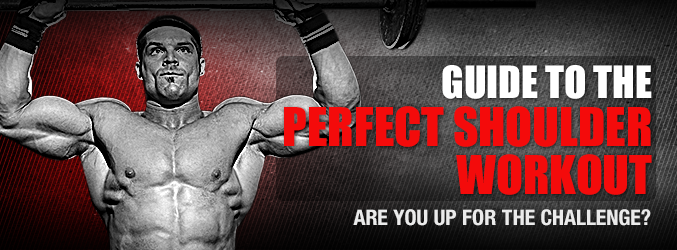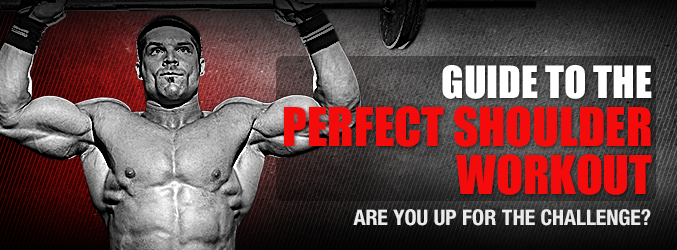
You’re an intermediate bodybuilder, making intermediate progress using intermediate training systems. Sound familiar? But there’s nothing intermediate about your desire to increase your training acumen so that you can move to the elusive lands of advanced muscle size and strength. And one of the most difficult areas to make progress is the shoulder muscle group. The deltoids are a 3-headed conundrum for lifters, mainly because their densely packed muscle fibers take so long to stimulate, injure easily, and are approachable from so many differing angles. Let’s look at a few variations and key training tenets for intermediate shoulder training that you can put to work to reach your best shoulder mass levels. Are you up for the challenge? Let’s dive in!

Train the shoulders alone
Too many lifters see shoulders as a small muscle group, like forearms or calves. We almost always tack these training sessions onto the tail end of another training day. Chest & shoulders, or back & shoulders… sound about right? This means, however, that the shoulders never receive the maximum effort which we are capable of exuding at the start of a workout. What is seen 40 minutes into a brutal training session, when the second muscle group starts, is usually far, far less in terms of intensity and resulting results. Your shoulders always receive a subpar workout as a result. Put your shoulders first, and they’ll quickly make the jump from intermediate to advanced. The fifth day of any 5-day-per-week training system should be devoted to training shoulder, and at most, another smaller muscle group afterwards. Abs, traps, or calves are usually preferable.

Don’t go so heavy
We usually stick with the decades-old mantra, “go with the one that brung you” when it comes to heavy training. When we were getting started, we used massive amounts of weight, and pushed ourselves to the limit, for movements such as squat, overhead presses, daedlifts, and bench press. And it worked, building up a base of muscle and strength which moved us from beginner to intermediate lifter. However, as we soon learned, this increasing arc cannot last forever. The joints, tendons, and even the muscles themselves have very strict limitations which become apparent over time. Every ten pounds we add to our squat is harder than the last. Gains in strength for advanced bodybuilders are measured in terms of single pounds, not heavy plates. As you become more advanced, it is imperative that you lower the amount of weight that you’re using, focusing instead of intensity, feel, solid sets, utilizing perfect form. Check your ego at the door and train for muscle stimulation, not bragging rights.
Free weights trump compound movements
Free weights should be the core base of your shoulder training. They’re a great tool to use at the tail end of a workout, when your balance starts to fail and you are no longer able to lift heavy weights for low repetitions. However, for the first half of any shoulder workout (at least!), you should be using heavy free weights for your lifting. This style of exercise recruits stabilizer muscles to work in the balance/control realm. And of course, the number of muscle fibers recruited is much higher. You grow big and strong from using free weights, and tight and tones by adding machine lifts for higher repetitions. Use them both, but always start with the heavy free weights as a rule. And this goes for all of your major muscle groups too!

Train all the heads
Most people know a few shoulder exercises, and they use them. They feel the shoulders burn as a single muscle group. Of course, the wise lifter is aware of the fact that the shoulder is actually THREE groups. The front deltoids are targeted with front DB raises, seated and standing barbell presses, and any other kind of press where you are facing forward, using barbell, machine, dumbbell, or cable. The side deltoids are targeted with side raises, including those using dumbbells, cables, or kettlebells, as well as any other machines. Use bent-over dumbbell, cable, and kettlebell raises to hit the rear delts. The reverse pec deck machine also isolates the rear deltoids. Use movements targeting all shoulder heads with each workout.
Watch for overlap
One of the biggest problems facing lifter when it comes to building shoulders is training imbalances. The triceps, shoulders, and pectorals work together on the bench press, often in an uneven state. Bodybuilders with some of the best arms around, often possess the weakest chests and shoulders around, because their arms do more of the work when it comes to training. Work to ensure you are using tools like pre-exhaust to work the intended muscle group. Perhaps more than any other muscle group, the shoulders benefit from isolation movements, followed up with compound movements. Your triceps won’t be doing all of the work (and reaping all of the benefits) from barbell presses, if you knock out a set of side dumbbell raises first to torch the deltoids.
Remember that there are some definite limitations to consider when training shoulders as an intermediate bodybuilder. If you’re a natural athlete, training without any hormonal assistance, then you are certainly going to make progress slower than your chemically assisted friends when it comes to training shoulders. But, as the months and years pass, your consistent progress will catch and eventually outpace what they can do using cyclical artificial means. Take your supplements to give yourself the greatest natural boost possible, eat right, and get plenty of rest. The gains will arrive, and they will truly be yours!


